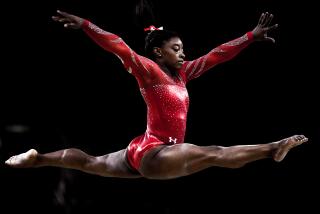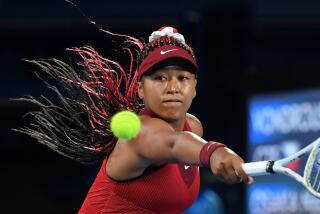Dokic Is Latest Act in Women’s Tennis Circus
- Share via
MELBOURNE, Australia — It is a new year, but the same old deal in women’s tennis. It is time for another Grand Slam event, the Australian Open, which means it is also time for women’s tennis to eat another of its young.
Women’s tennis is death and taxes. The names change, but never the certainty of melodrama.
At last year’s French Open, No. 1 player Martina Hingis lost to veteran Steffi Graf in the final, left the court in tears before all the ceremonies had taken place and had to be dragged back out by her mother.
A few months later, at Wimbledon, Hingis showed up without her mother and promptly lost in the first round. The player beating her was an Australian, 15-year-old Jelena Dokic. Dokic was not highly ranked but also not unknown. Just before Wimbledon, her father had been tossed out of a tournament at Birmingham, England, for loudly jeering during one of her matches and then, once outside, had lain down in the road, blocking traffic.
In September, at the U.S. Open, Jennifer Capriati was well on her way to reconstructing her career. It had come apart for a while because, basically, she had wanted a chance to be a normal teenager and thought that should include trying drugs. She got caught, went through a couple of difficult years, on and off the tennis court, and then came back. But after an early-round match at the Open, she read a statement to the media that demanded they never again ask her about her past. By then, reporters were pretty much done doing that, at least until she made it an issue again. Eventually, seeing her father in the back of the room run his finger across his throat, she broke down in tears and left the room.
Now, it is Dokic’s turn on the merry-go-round.
She entered the event on her home turf as the local hope, and it all came apart immediately. Ranked No. 39, she lost in the first round to No. 89 Rita Kuti Kis of Hungary. Dokic stalked off, disappeared for hours instead of doing her mandatory news conference, then showed up with a statement to read, a la Capriati, and instead of reading it, dumped on Kuti Kis as somebody who has “never been a player and I guess probably never will be.”
Things disintegrated quickly from there. The next day, Dokic told a reporter that the draw had been manipulated to hurt her. Shortly after that, when she was leaving a hotel with her father, Damir, a television photographer started filming. Damir Dokic lunged at the cameraman, took the camera away momentarily and then, shortly after, offered the cameraman $500 for the videotape of the altercation.
This, of course, is great tabloid stuff. And while this isn’t London and they don’t feature pictures of nude women on Page 3 of their papers here, there remains enough of a fascination with this to have it become an ongoing story.
It’s hard to know who to blame for these things. The candidates are as follows:
* The media for overdoing it, for pandering to this ever-present titillation;
* The players themselves, for not understanding their public persona and public accountability and responding accordingly;
* Or the people around the players--tour officials, coaches and parents--for not teaching adult behavior, perhaps by example, to these children of whom we ask so much in the way of early maturity.
One thing is indisputable. The proportion of dysfunction and controversy swirling around women’s pro tennis is incredible.
Mary Pierce had to get a restraining order to keep her father away and the WTA Tour eventually banned him for life from their events.
Venus and Serena Williams have suffered through several distractions triggered by their controversial father, Richard, who once called tour player Irina Spirlea a “big white turkey,” and had a verbal exchange with Hingis at last year’s U.S. Open.
Alexandra Stevenson had a breakout tournament at Wimbledon last year, coming from nowhere to the semifinals. Whereupon it was revealed that her father was former basketball star Julius Erving, something her mother, Samantha Stevenson, a sportswriter who wrote about Erving in his playing days, had tried to keep secret.
There was Patty Schnyder. The Swiss player who won five titles and nearly $1 million in 1998 left her boyfriend in early ’99 and took up with a 42-year-old self-proclaimed health guru named Rainer Harnecker, who had her eating only fruit and vegetables and subsisting only on orange juice before 2 p.m. each day.
In many ways, if women’s tennis were a blimp, it would be the Hindenburg.
The story, of course, is not all bad. The retired Graf, who had her own problems with her father and the tabloid attention he and his girlfriends and tax problems attracted, is here and appears to be reveling in the unabashed manner in which she is being courted by Andre Agassi. Mary Joe Fernandez and Pam Shriver, great players and great role models during their careers, are here doing media work and could very easily be tapped for their expertise.
But the best news is that Lindsay Davenport is playing well and maintaining her high stature on the tour and is not afraid to speak up when others who should intervene just duck and run.
Davenport said Wednesday that Dokic’s statement that the draw was rigged was “laughable” and “some of the dumbest stuff I have ever heard.” She also said that she hoped to get a chance to ask Dokic, to her face, “What are you thinking?”
But, most significant, she said that it might be good for some of the senior players on the tour to sit Dokic down, talk to her, and tell her, “This is silly.”
Therein lies the seed of a great idea. Gather the players in a huge room. Put Davenport, Fernandez, Shriver and a few other adults at the front of the room. And before locking the doors, put up a sign outside that says:
No media.
No tour officials, advisors or coaches.
And especially: NO PARENTS.
More to Read
Go beyond the scoreboard
Get the latest on L.A.'s teams in the daily Sports Report newsletter.
You may occasionally receive promotional content from the Los Angeles Times.











